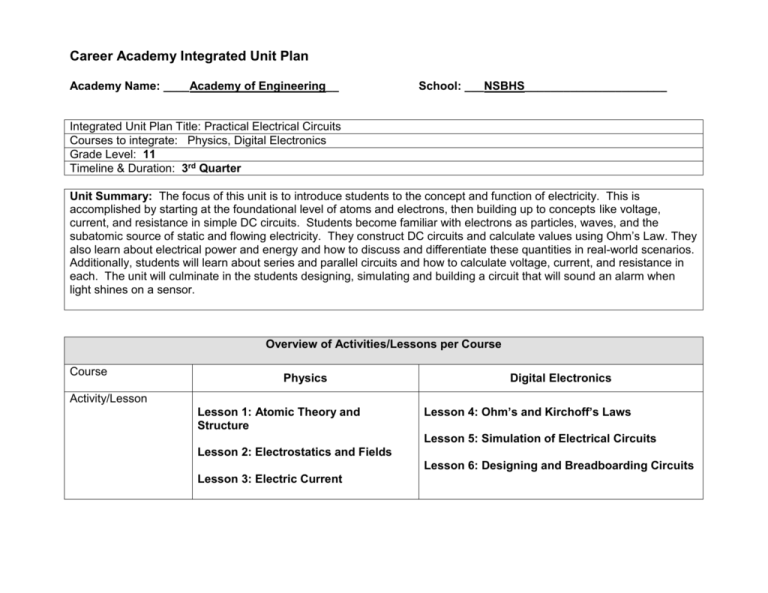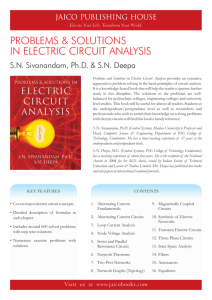01Grade 11 (Physics and Digital Electronics)
advertisement

Career Academy Integrated Unit Plan Academy Name: ____Academy of Engineering__ School: ___NSBHS______________________ Integrated Unit Plan Title: Practical Electrical Circuits Courses to integrate: Physics, Digital Electronics Grade Level: 11 Timeline & Duration: 3rd Quarter Unit Summary: The focus of this unit is to introduce students to the concept and function of electricity. This is accomplished by starting at the foundational level of atoms and electrons, then building up to concepts like voltage, current, and resistance in simple DC circuits. Students become familiar with electrons as particles, waves, and the subatomic source of static and flowing electricity. They construct DC circuits and calculate values using Ohm’s Law. They also learn about electrical power and energy and how to discuss and differentiate these quantities in real-world scenarios. Additionally, students will learn about series and parallel circuits and how to calculate voltage, current, and resistance in each. The unit will culminate in the students designing, simulating and building a circuit that will sound an alarm when light shines on a sensor. Overview of Activities/Lessons per Course Course Physics Digital Electronics Activity/Lesson Lesson 1: Atomic Theory and Structure Lesson 4: Ohm’s and Kirchoff’s Laws Lesson 5: Simulation of Electrical Circuits Lesson 2: Electrostatics and Fields Lesson 6: Designing and Breadboarding Circuits Lesson 3: Electric Current Lesson Instructions for Physics: Standards (NGSSS): SC.912.P.8.3, SC.912.P.8.4, SC.912.P.10.9, SC.912.P.10.10, SC.912.P.10.13, SC.912.P.10.14, SC.912.P.10.15 Rigor & Relevance (quadrant): A, B Instructions to Teacher: Present the following 3 Lessons in 24 class periods (Sessions). These lessons are designed to be use PowerPoint slides to present information and encourage question/answer and discussion throughout the presentation. Included are suggested practice problems (PP) from the textbook “Conceptual Physics” (Paul Hewitt), Worksheets (WS), Videos, and Demonstrations (Demos). Lesson 1: Atomic Theory and Structure Session 1: PowerPoint – Atoms and Early Atomic Theory (origination, relative size, Dalton model) (PP: p. 256-257 #1-4, 6, 8, 27-28) WS: Defining the Atom Session 2: PowerPoint – The Atomic Nucleus (Rutherford experiment and model) (PP: p. 257 #14-19, 30-32) WS: The Nuclear Atom Session 3: PowerPoint – Electrons in Atoms (Bohr model, de Broglie wave model) (PP: p. 608 #10-15, 28) Video: Turning Points in the Physical Sciences 1903-1928 Chp 6: 1925 Wave-Particle Duality (Safari Montage) Session 4: PowerPoint – Electrons and Light (quanta, dual nature, photoelectric effect, quantum mechanics) (PP: p.607-608 #2-3, 5-9, 19-22, 24-26) Session 5: Video: Atoms & Quantum Mechanics (Safari Montage) Session 6: Review for Unit Assessment Session 7: Unit Assessment Lesson 2: Electrostatics and Fields Session 8: PowerPoint – Charge and Electrostatic Force (F = qE, conservation of charge) Demo – bend thin stream of water with charged plastic spoon without contact (PP: p. 515-516 #1-3, 5-7, 9-13, 26-28, 34) Session 9: PowerPoint – Coulomb’s Law and Charging (conductors, induction) Demo – charged balloons on string repel each other (PP: p. 516 #16-21, 29-33) Session 10: Video: Static Electricity (Mechanical Universe) Demo – Van de Graff Generator Session 11: PowerPoint – Electric Fields (magnitude and direction, field lines) Video Clip: Car Lightning (Top Gear) (PP: p. 529-530 #3-10, 21, 24) Session 12: PowerPoint – Electric Fields, Charge, and Force (calculations, interpretation of field lines) WS: Electric Field Calculations Session 13: PowerPoint – Electrical Potential Energy and Electric Potential (energy vs. voltage, capacitance) (PP: p. 529-530 #11-16, 18, 27, 29, 31-32) Session 14: Video: Voltage, Energy, and Force (Mechanical Universe) Session 15: Review for Unit Assessment Session 16: Unit Assessment Lesson 3: Electric Current Session 17: Video: Electric Potential Difference (Georgia Public Broadcasting 804) Session 18: PowerPoint – Voltage and Current Video: Introduction to Electric Current (Georgia Public Broadcasting 901) (PP: p. 545-547 #1-5, 26-27, 35, 44-45) Session 19: PowerPoint – Voltage and Resistance (water pipe analogy) (PP: p. 545-547 #6-11, 36, 38, 47) Session 20: PowerPoint – Ohm’s Law (V = IR) Video: Ohm’s Law (Georgia Public Broadcasting 902) (PP: p. 546-547 #12-16, 28-32, 40, 46) Session 21: PowerPoint – Electrical Energy and Power (P = IV) (define “electricity” in terms of energy and power) (PP: p. 546-547 #22-25, 33, 48 then 43, 49, 51) Session 22: Video: Electric Circuits (Mechanical Universe) Session 23: Lab Activity: Ohm’s Law and Circuits (PhET, online simulations titled Battery-Resistor Circuit, Ohm’s Law, and Circuit Construction Kit) Session 24: Review for Unit Assessment Session 25: Unit Assessment Video: Power and Series Circuits (Georgia Public Broadcasting 903) Instructions to Students: Consider the presentations of these topics. Ask questions and freely discuss the concepts. Complete the assignments in preparation for the unit assessment. These 3 lessons will prepare you for further application of these concepts in your engineering course in preparation for your culminating project. Lessons 1, 2, 3 Sessions 1-25 Instructions for Student Accommodations: extended time as necessary, copy of notes handed out with highlighter Assessment for Lessons: Discussion. Review of work completed in each session. Unit Assessments. Approximate Length of Time for Lessons: 6 weeks Materials Needed: Lesson 1 • PowerPoint – Atomic theory and Structure (includes all presentations for Lesson 1) • Worksheet – Defining the Atom • Worksheet – The Nuclear Atom • Video: Turning Points in the Physical Sciences 1903-1928Chp 6: 1925 Wave-Particle Duality (Safari Montage) • Video: Atoms & Quantum Mechanics (Safari Montage) • Unit Review and Assessment Lesson 2 • PowerPoint – Electrostatics and Fields (includes all presentations for Lesson 2) • Demo – Buret or Faucet for this water stream, plastic spoon and wool or similar material • Demo – 2 balloons tied to each end of a string hanging over a meter stick • Video: Static Electricity (Mechanical Universe) • Video: Car Lightning (Top Gear) • Unit Review and Assessment Lesson 3 • PowerPoint – Electric Current (includes all presentations for Lesson 3) • Video: Electric Potential Difference (Georgia Public Broadcasting 804) • Video: Introduction to Electric Current (Georgia Public Broadcasting 901) • Video: Ohm’s Law (Georgia Public Broadcasting 902) • Video: Electric Circuits (Mechanical Universe) • Lab Activity: Ohm’s Law and Circuits (PhET, online simulations titled Battery-Resistor Circuit, Ohm’s Law, and Circuit Construction Kit) • Unit Review and Assessment • Video: Power and Series Circuits (Georgia Public Broadcasting 903) Resources Needed: Online video streaming access to Mechanical Universe (http://www.learner.org/resources/series42.html), Georgia Public Broadcasting (http://www.gpb.org/chemistry-physics), Safari Montage (http://videoservicesondemand/SAFARI/montage/login.php?fromlogoutlink=true&login), and Top Gear (http://www.topgear.com/uk/videos/car-lightning). PowerPoint presentations, listed Worksheets, Unit Reviews and Assessments for each lesson, calculators (1 per student), Van de Graff generator, listed supplies for demos, Textbook (Conceptual Physics by Paul Hewitt, 2006), 1 computer per student to complete online Lab simulations at http://phet.colorado.edu/ (including Battery-Resistor Circuit, Ohm’s Law, and Circuit Construction Kit) Attachments: See resources and materials listed. Email jlbrock@volusia.k12.fl.us for documents and files. Lesson Instructions for Digital Electronics: Standards (FLDOE Pathways to Engineering – Course: Digital Electronics): 29.04, 29.05, 29.06 Rigor & Relevance (quadrant): C, D Instructions to Teacher: Present the following three lessons over a 15 day period. The PowerPoints and worksheets come from Project Lead The Way Digital Electronics curriculum. Following an introductory PowerPoint on Ohms and Kirchoff’s Laws, students will perform hand calculations of series and parallel circuits, followed by simulating the circuits on MultiSim software. Final culminating event will be students designing and building a circuit sensitive to light. Lesson 4: Ohm’s and Kirchoff’s Laws Session 26: PowerPoint – CircuitTheoryLaws.ppt, students take notes in their journals. Follow with practice calculations. Session 27: Review of Kirchoff’s Laws, students begin work on Activity 1.2.2 Circuit Theory – Hand Calculations. Session 28: Continue working on Activity 1.2.2 Session 29: Finish Activity 1.2.2. Quiz on series/parallel circuits. Lesson 5: Simulation of Electrical Circuits Session 30: Demonstration of MultiSim software – how to build a circuit, attach multimeters and take readings. Students build a simple series circuit using MultiSim. Session 31: Students work on Activity 1.2.3 Circuit Theory – Simulation. Session 32: Finish Activity 1.2.3 Lesson 6: Designing and Breadboarding Electrical Circuits Session 33: Component Identification.ppt – How to use a multimeter and how to identify resistor resistance. Session 34: Activity 1.1.3 Component Identification – Using multimeters, students calculate and check the resistance value of different resistors. Session 35: Breadboard.ppt – students will take notes on how to build a circuit using a breadboard. Session 36: Activity 1.2.4 Circuit Theory – Breadboarding. Build and test series and parallel circuits. Session 37: Finish Activity 1.2.4 Session 38: Final Project – Close the Refrigerator Door! Students will calculate resistor values in order to breadboard a circuit that will sound a buzzer when light shines on a photoresistor. Session 39: Finish light alarm project. Instructions to Students: Take notes during PowerPoints. Ask for help during practice problem time. Make sure you understand how to apply Kirchoff’s Laws before simulating the circuits. Work with your partner, taking notes and making sketches of your light circuit. Get approval of your final design before breadboarding. Lessons 4, 5, 6 Sessions 26-39 Instructions for Student Accommodations: Extended time as necessary. Assessment for Lessons: Discussion. Review of work completed in each session. Successful completion of simulated circuits, breadboarded circuits, and final project. Approximate Length of Time for Lessons: 3 weeks Materials Needed: Lesson 4 • PowerPoint - CircuitTheoryLaws.ppt Worksheet - Activity 1.2.2 Circuit Theory – Hand Calculations Lesson 5 MultiSim 11.1 software Worksheet - Activity 1.2.3 Circuit Theory – Simulation Lesson 6 • PowerPoints - Component Identification.ppt, Breadboard.ppt Worksheets - Activity 1.1.3 Component Identification, Activity 1.2.4 Circuit Theory – Breadboarding, Close the Refrigerator Door! Resources Needed: PowerPoints and Worksheets listed, MultiSim 11.1 software, breadboards, wires, multimeters, resistors, photoresistors Attachments: PowerPoints and worksheets as listed, proprietary PLTW curriculum.





